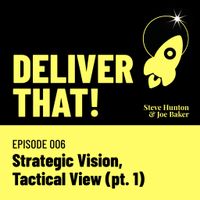Holding the creative tension between strategy and execution is a distinctive quality of a Chief Delivery Officer.
The role requires you to do both:
- to see far ahead, and determine how to get where you're going
- and, to take one step at a time on the path you've set, without getting distracted or discouraged.

In part 1 of this conversation we talk about the first part — the need to build a delivery strategy and how you might go about doing that.
We start by asking the big 'why?' question — why do you even need a delivery strategy in the first place? — which is actually two questions:
- Why are we doing what we’re doing?
- Where do we want to be in 6/12/24/whatever months, and why?
We then spend a while milking a powerful but progressively more tenuous metaphor:
Walk up the hill to see the horizon #
At ground level, things can appear quite suddenly and erratically, almost as if out of nowhere. That'll cause you big problems, as if you're always putting in effort just to stand still. And it's because your view is too short — the horizon is very close, where things can hit you without much warning.
You need to get to higher ground where the horizon is further out and your view is both longer and broader, taking in the landscape all around you.
- Keep focused on the end-goal, on the outcome you want
- Take account of what's immovable in between
- Evaluate what's moving, and understand the risk it poses on your path
- Choose the optimum route to get to that destination
- Work out a plan for the journey you're going to take
- Test that plan as thoroughly as you can, so you're not unduly surprised
- Break the whole thing down into achievable steps
- Work out how you're going to know how you're getting on when your vision isn't as clear, when things get tough
- Put in place the team and the equipment you'll need along the way
How do you get going? What does a delivery strategy look like? #
In the second half of the show we talk more about how you can build a strategy, and some of what you should be including in your strategy.
We talk about important elements, like …
- Problem sourcing
- A methodical practice for identifying problems in the business, proposing solutions, and determining priorities
- Processes
- The systems needed for what should be done at different stages of the organisational lifecycle
- Tools and methods
- The right practices of the right kind for the specific configuration and context of your team
- Ways of working
- What is the operating model for your team to work together, to achieve consistency and quality?
- Documenting all the things
- Creating the map for the journey you're going to be taking
- Metrics
- Understand the progress you're making — what gets measured gets managed
